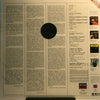





Schubert - Sonata for Arpeggione & Schumann - Fantasiestucke – Mischa Maisky & Martha Argerich (Enregistrement Digital)
Franz Schubert - Sonata For Arpeggione And Piano In A Minor, D. 821
Robert Schumann - Fantasiestücke Op. 73 & Stucke Im Volkston, Op. 102
Mischa Maisky, cello
Martha Argerich, piano
1LP, standard sleeve
Original analog Master tape : NO (Digital Recording Original Master Tape)
Heavy Press : 180g Virgin vinyl
Record color : Black
Speed : 33RPM
Size : 12'’
Stereo
Studio
Record Press : Pallas (Germany)
Label : Analogphonic
Original label : Philips
Recorded January 1984 at La Chaux-de-Fonds, Suisse
Mastered by Maarten de Boer at Emil Berliner Studios
Liner Notes by Claude Hermann
Sleeve Notes by Joan Chissell and Wilhelm Pfannkuch
Photography by Klaus Hennch
Originally released in May 1985
Reissued in January 2023
Tracks :
Side A : Schubert - Sonata for Arpeggione and Piano in A minor, D.821
- Allegro moderato
- Adagio
- Allegretto
SIDE B :
Schumann - Fantasiestücke, Op.73
- Zart und mit Ausdruck
- Lebhaft, leicht
- Rasch und mit Feuer
Schumann - 5 Stücke im Volkston, Op.102
- Vanitas vanitatum (Mit Humor)
- Langsam
- Nicht schnell, mit viel Ton zu spielen
- Nicht zu rasch
- Stark und markiert
Reviews:
In 1823 Johann Georg Staufer invented the arpeggione, a six-stringed instrument with the fretted fingerboard and tuning of a guitar but played with a bow, like a viola da gamba. Though its survival was brief, it found one notable Viennese exponent in Vincenz Schuster, who even published a tutor for it. Schubert's single work for arpeggione, nowadays most often appropriated by cellists, was composed for Schuster in November 1824, a year memorable for the 27-year-old composer's return to health, after serious illness, and also his return to the sphere of chamber music.
"All the instruments are having a turn" was Clara Schumann's diary comment in the spring of 1849 as her husband, approaching his thirty-ninth birthday, wrote miniatures for clarinet, horn, and cello with piano (oboe and viola suites soon followed). With her own concert travels restricted by a fast-growing family, domestic music-making with friends from the Dresden Court Orchestra proved a constant source of pleasure for them both.
The "Fantasiestucke" for clarinet, Op. 73, dated February 11-12, 1849, were in fact tried out by Clara with the clarinettist, Johann Kotte, barely a week later, though Schumann at once stipulated that they were no less apt for violin or cello as clarinet. The word attacca after Nos. 1 and 2 as well as the A minor-major key-scheme reveals that Schumann envisaged the three pieces as a continuous suite travelling in mood from nostalgic lyricism to firm resolution.
Ratings:
Discogs : 4.89 / 5


